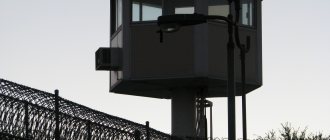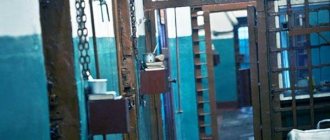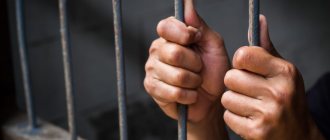South Africa is a country where it is better not to sit
In Africa it is easier to go to prison than not to go to prison.
The problem is widespread poverty on the streets, which is why some resort to illegal actions. In South Africa, for example, fines are rarely imposed because the population is not able to pay them. Therefore, there is only one road - to prison. But if your offense is minor, then you may be given a flogging. Yes, such things still exist in South Africa. Yes, in the country that hosted the 2010 World Cup, you can see such barbaric methods of punishment. However, this is not surprising, because there is no criminal code here. On what grounds a preventive measure is chosen is unclear. Sometimes it comes to the point that the decision is made by the elder of the tribe from which the person comes. Life in the zones is not rich, just like the life of African countries in general. The hardest thing is that not everywhere there is a division into women's and men's prisons. Many places of detention accommodate twice as many people as they should. It is not surprising that more than half of those sitting are sick with AIDS. Therefore, every day on average 3 people die in the country's prisons. In general, hell on earth. The prisoners have little to brag about. Apart from a khaki uniform, they have nothing. It's better to think with your head before you do something stupid in South Africa. Serving a couple of years and being released is the best thing that can happen to you here in case of an offense.
China and prison cities
China is a progressive economic state. But it’s not at all humane. Because every person within the country is under total control. The government has introduced ways to influence the population: electronic karma and a facial recognition system. Now think about where this was tested. After all, you can’t just enter something without knowing whether it works or not.
China used the local ethnic minority, the Uyghurs, as experimental mice. In western China, near the border with Kazakhstan and Kyrgyzstan, the Xinjiang province is located. In the 40s of the last century, the communists of the Middle Kingdom annexed this territory for themselves. This is where those same Uyghurs live. They have a different culture and religion (Islam), which does not fit into the Chinese framework.
The government tried for a long time to assimilate the people, but nothing succeeded. Then the authorities took advantage of the 2009 case. There was a rumor that a group of Uyghurs raped a Chinese woman in Urumqi. The Chinese population of the city came out to a spontaneous rally. They demanded reprisals against the criminals. This is where the most interesting thing happened. The government said:
“If we don’t re-educate the Uyghurs, things will get worse.”
As a result, repression began in Xinjiang. The government spent $8 billion on its cruel games. Urumqi, a city of over a million, has turned into a testing ground. Cameras, police and everything you need for an ideal dystopia. Residents were labeled into three categories: Chinese, safe Uyghur and unsafe. The latter are no longer on the city streets. No, they are not sitting at home - they are being exiled en masse to camps. Imagine: every tenth representative of this national minority is in a “re-education center”. This is how assimilation is carried out in China.
We'll add a little more tin, so don't relax. In the colonies, prisoners have no time for chess made from bread crumbs. They are instilled with the basics of communism, prohibited from practicing religion, and taught the Chinese language. In general, they turn into full-fledged citizens of the country. Or robots, whatever you want to call them. The day begins with exercise at 7 am with the national anthem and flag raising. Thus, an alien culture is forcibly instilled. If you do not agree, you will be subject to torture. Therefore, after two years you come out of there like silk.
Propaganda tools also work outside the concentration camp. There are dozens of mosques in the million-plus city of Urumqi. But none of them work. Bans on beards and conversations with Muslim relatives are the apogee of cruelty. Total surveillance, metal detectors, passport control and a sea of police - this is what the locals live among. Lack of freedom in the colony and beyond.
"Polar Owl"
A special regime correctional colony located in the village of Kharp. Currently, people sentenced to life are being held here.
The gated community of Kharp was built in 1961. The colony, located on its territory, was intended to contain persons disliked by the Soviet regime. Moreover, the walls of the “Polar Owl” were erected by the convicts themselves.
Today this correctional institution is considered one of the most remote prisons in the Russian Federation, since it is located outside the Arctic Circle. It also has the highest mortality rate among prisoners. Many of the prisoners simply cannot withstand the harsh conditions of the Far North.
“Polar Owl” is known for the fact that not a single prisoner tried to escape from here during the entire period of the colony’s existence. And this is explained not only by the presence of good security, but also by the harsh climate. Once outside the prison, the prisoner will most likely die before reaching the nearest settlement.
The Polar Owl currently houses the most dangerous criminals, including maniacs and repeat offenders. Prisoners are serving life sentences here without the right to rehabilitation.
Norway: Criminals are people too
On social networks 7-8 years ago, news was actively promoted about the conditions of detention of the Norwegian terrorist Anders Breivik. He killed 77 people. You probably remember the terrible events in Oslo in 2011. So, many were surprised that the maniac would be kept in a five-star hotel. A soft bed, like a grandmother’s in the village, a work area with a computer and a window overlooking the garden. The confusion among people is easy to explain. In our minds, a person who has committed a crime must rot out the remains of his life on a hard bunk. This is his legal punishment for what he did. Norway treats prisoners humanely. The main argument in favor of such views:
“We let criminals know that they are people too. They can reform and live among people.”
Evil does not thrive inside Norwegian prisons. There are no crime bosses or thieves in law here. Prisoners conduct introspection and look for a place in life. The state is trying to return them to society and teach them how to live. In our prison, prisoners fit into the established framework of “concepts” and emerge as carriers of the AUE culture. It's logical. Statistics on repeat offenders confirm this argument. In Russia, 70% of criminals repeat their rotten experience. In the USA - 80%. At least in some ways they are better than the Americans. In Norway, only 20% of people go to the colony again.
In order to fight the evil in the hearts of criminals, in Scandinavia they are placed in normal conditions. Sports grounds help keep the body in shape, access to literature gives a chance to enrich oneself culturally, and working with a psychologist eradicates the source of the problem. Thus, the prisoner develops within the framework of traditional society. Unlike China, here people are free to choose the boundaries of their interests. The main thing is to remain humane.
"Butyrka"
Pre-trial detention center No. 2, famous throughout the country, was opened in 1771. “Butyrka” was created by order of Catherine II, and at that time it was called the Provincial Prison Castle. The building was built according to the design of Mikhail Kozakov. The correctional facility was decorated with four towers. Between the prison walls there was a small church, which later became the Church of the Intercession.
At different times, Butyrka housed different criminal populations:
- At the end of the 19th century, convicts escorted to Siberia were temporarily stationed here.
- During Soviet times, Butyrka was used to house political criminals. Moreover, during the period of Stalinist repressions, 150-170 prisoners could stay in one cell. The total occupancy of the correctional facility at that time reached 20,000 people.
- Currently, suspects and convicts are kept here.
The cruelty of keeping prisoners in Butyrka has given rise to numerous legends. So at the beginning of the last century, due to inhuman conditions of detention, prisoners simply committed suicide. Moreover, suicide was a widespread phenomenon here at that time.
For example, convicts were forced to scrub the floors in their cells until they were shiny. Cleanliness was checked using a handkerchief. If there was dust on it, the prisoner responsible was sent to the punishment cell.
The punishment cells were located in the basement. Numerous instruments of torture were subsequently discovered here.
Until 1994, Butyrka was the main place in Moscow where prisoners were executed. And many of those killed did not commit the crimes charged to them. The largest number of executions was recorded in 1941, when about 200 executions were carried out daily.
When the death penalty in Russia did not lose its notoriety. Today, cells can hold up to 25 people at a time. Prisoners are not prohibited from smoking, and therefore there is practically a smoke screen in the poorly ventilated room. It is extremely difficult to breathe in such conditions. At the same time, walks in the fresh air are a rare occurrence in Butyrka.
Today this pre-trial detention center consists of 10 buildings. They contain the following contingent:
- juvenile delinquents;
- persons under investigation;
- female prisoners;
- convicts awaiting transfer;
- repeat offenders.
The USA is the most criminal country in the world
In the USA there are problems with safety on the streets. 80% of those in prison are prone to relapse. The country also ranks first in the world in terms of the number of prisoners: 655 prisoners per 100 thousand people. For comparison: in Russia the figure is almost 2 times less. The fight against crime in the States is less productive than in Norway.
There are 7 thousand correctional institutions in the country. Agree, this does not fit with the idea of the most democratic country. Particularly surprising is the fact that there are more prisons than colleges and universities.
What makes local prisons stand out is the presence of clans. Blacks and Latinos are constantly at odds with each other. The plot of the film “Shoot into the Void” is quite true. Therefore, if you sit down, be prepared to join one of the groups. Otherwise, while walking you will snatch from both one and the other. By the way, the walking areas in prisons are spacious. If you haven’t done anything wrong, then you’ll sit where you can freely walk around the yard, go to the rocking chair or play basketball with the black kids.
There is nothing unusual in the cell: two bunks and that’s it. The prisoners share showers. By the way, prisoners do not welcome those who spread violence inside the zone. Homosexuality is not in fashion with them; they are disgusted to live in such an environment. But there is a place for tenderness: Latinos love to watch soap operas. Perhaps they watched the American version of “House-2”. Black people turn on music channels. And don’t even think about switching! For this you can get a sharpening in the liver.
"White Swan"
Although White Swan Prison is designed to house just over 500 people, it actually houses about 2,000 prisoners. For the first decade, convicts are not allowed to correspond with relatives and friends, and visits are also prohibited. This opportunity appears only after 10 years. Distinctive features of the prison: cells for only 3 people, work in carpentry workshops and a temple located on the territory. O prisoners more often than usual become deeply religious.
Russia and the romance of the zones
Russian prisons are a separate topic for discussion. Only in our country the place of serving a sentence is so romanticized. AUE culture, concepts and thieves' chanson are still in demand in society. You know for sure that you need to answer the question about a fork in the eye, because in our environment this is a common topic.
The Russian prison differs from all others because of its prisoners. Or rather, their ingenuity. They came up with hundreds of ways not to die of boredom. Tattoos, songs, gambling and much more help pass the time. By the way, you can bring a mobile phone into a prison with a lower security regime and post your photos to the public page “Overheard in the Zone.” It’s not difficult to meet “smooth women” who will wait until you, poor fellow, “lay back.” The main thing is not to be considered a rooster.
In zones like the Black Dolphin, everything is much stricter. People never leave there, and life there is completely different. There are constant checks, and prisoners are led around the perimeter with a blindfold - so they won’t remember the layout of the building.
The living conditions are not the most comfortable, but the hands are trying to equip their shack. You can get a fresher sheet, snatch an old TV, or find a mattress without yellow spots if you make good contacts. It’s difficult here without connections, because the rules of residence are often dictated by local authorities. Therefore, it would not be a bad idea to warm someone up with tea or cigarettes.
Vladimir Central
0
Glorified by Mikhail Krug, the Vladimir Central is in fact completely devoid of both romance and any charm. In reality, this place is one of the most terrible prisons in Russia, intended for especially dangerous criminals. Built by order of Catherine II at the end of the 18th century, in the 20th century the central house received prisoners of the level of Adolf Hitler’s head of personal security, Hans Rattenhuber, but among the “especially dangerous” there were also such people as singer Lydia Ruslanova, writer Daniil Andreev and actress Zoya Fedorova. In Soviet times, spies, saboteurs, terrorists and other “anti-Soviet” and counter-revolutionaries were stationed in the central area.
0
Interesting fact: in the 90s, Mikhail Krug repeatedly performed at the Vladimir Central. The singer knew both the head of the central prison and many of his employees, and therefore it was not difficult for him either to give concerts in prison or to visit his acquaintances who from time to time found themselves there as guests.
Australia: psychonauts behind bars
Liberalization is an excellent method for rehabilitating prisoners. There are ultra-modern colonies, like in Norway. But most of them still look familiar to you. Nevertheless, relaxations are being introduced there. Let's say condoms began to be supplied to men's prisons. The experience is, of course, interesting, but something tells me that this will not help in the correctional process. There are also useful things, for example, prisoners are provided with good medicine and expensive operations are available to them. Local prisoners are also fed unconventionally. No, they do not eat eucalyptus, but for lunch they may be offered Chinese, Malay or Japanese cuisine. Breakfast is typically English: scrambled eggs with bacon, sausages and tea. At school, my morning meal consisted of semolina with lumps or an egg with squash caviar.
But there are also negative aspects. In some prisons, guards start a business. They sell phones to prisoners, and other guards then take away the means of communication. Confiscated mobile phones are then sold again. A simple method to make money out of thin air.
Convicts in Australia like to have fun with drugs. Using local flora and fauna, they synthesize psychedelic substances in their cells and work areas. There was a case when prisoners were caught growing cannabis in greenhouses. But they were not upset for long, and later one resourceful guy made a knight move. He suggested that the prison governor keep the inmates busy catching frogs, which often plague the grounds. As a result, from the skins of these toads, the guys brewed a psychedelic drug that was not inferior in its properties to LSD. With their intelligence, they can compete with prisoners from Russia.
Iceland and prison queues
The safest country in Europe also needs prisons. There are only 6 of them here. But getting into them is not so easy. Let's say you stole a car. You were caught, arrested and released. But what about the punishment, you ask? And it will come to you in 5 years. The fact is that there are not many places in the colonies, and you will have to wait until your turn comes.
“It often happens that people start a new life, maybe start a family, get an education, find a job. And then we show up to put them in prison for two years on a five-year-old sentence, which, of course, is completely irrelevant, and it shouldn’t be that way,” says Paudl Winkel, head of Icelandic penitentiaries.
The prisons on the island are not particularly strict, because you can count the murderers on the fingers of one hand. The prisoners prepare food for themselves and the guards and eat together at the same table. The guards always thank the inmates for a delicious meal and go on about their business.
Iceland is such a small country that prisons are located next to bars, and prisoners, hearing the sounds of fun, often ask the authorities to let them go for a walk around the city. In places where “office employees” are imprisoned for economic crimes, such concessions are made. Icelandic society believes in people and gives them a chance to improve without fear for their safety.
The conditions and principles of imprisonment in prisons of different countries are radically different. Progressive states use humane methods to re-educate people. They give him a chance to start life from scratch. Other colonies intimidate inmates and consider cruelty an excellent method of “settling their brains.” Which method do you think is most appropriate?
"Black Golden Eagle"
The last refuge for ruthless murderers, terrorists and rapists is the Black Golden Eagle prison, located in the middle of the remote taiga. A joyless stay here is aggravated by severe frosts in winter and a huge number of small insects in summer. The unfavorable climate and many kilometers of forest around will not allow the prisoners to escape. There was only one attempt to escape from the Black Golden Eagle, and it ended very sadly - the “runner” soon died.
Prisoners are kept in 6-meter cells for 24 hours, only being able to leave for 50 minutes during the entire day. The lack of amenities, the need to relieve oneself in barrel-shaped containers and, as a result, the terrible 24-hour stench in the room - as an additional punishment for malicious criminals. The only entertainment here is reading books.
According to some reports, approximately 30% of prisoners rarely endure this regime for more than 10 years. Many go crazy, die or try to commit suicide.











